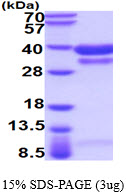Recombinant Mouse Ctsb Protein (NP_031824) (18-339aa) with C-terminus His tag was expressed in Insect cells.
| Size | Price | Qty |
|---|---|---|
| 50ug | $495.00 |

1. Sigloch, Florian Christoph; Knopf, Julia Daniela; Weisser, Juliane; et al. BIOCHIMICA ET BIOPHYSICA ACTA-MOLECULAR CELL RESEARCH. 1863-11,2700-2709
"Cathepsin B (CTSB) is a lysosomal endo- and exopeptidase that is also secreted in high amounts by malignant and non-malignant cells. We determined the effect of CTSB on the tumor cell secretome by shRNA-mediated silencing of CTSB mRNA expression and subsequent proteomic LC-MS/MS analysis of the cell supernatants. We identified significant protein changes of 17 secreted or shed proteins."
2. Moon, Hyo Youl; Becke, Andreas; Berron, David; et al. Running-Induced Systemic Cathepsin B Secretion Is Associated with Memory Function, CELL METABOLISM, 24-2,332-340
"Here, we show that a muscle secretory factor, cathepsin B (CTSB) protein, is important for the cognitive and neurogenic benefits of running. Proteomic analysis revealed elevated levels of CTSB in conditioned medium derived from skeletal muscle cell cultures treated with AMP-kinase agonist AICAR. Consistently, running increased CTSB levels in mouse gastrocnemius muscle and plasma. Furthermore, recombinant CTSB application enhanced expression of brain-derived neurotrophic factor (BDNF) and doublecortin (DCX) in adult hippocampal progenitor cells through a mechanism dependent on the multifunctional protein P11."
3.Jiang, Yong; Woosley, Alec N.; Sivalingam, Nageswaran, et al. Cathepsin-B-mediated cleavage of Disabled-2 regulates TGF-beta-induced autophagy, NATURE CELL BIOLOGY, 18-8, 851-+
"Here we show that following TGF-beta-mediated EMT, sustained TGF-beta treatment leads to proteolytic degradation of Dab2 by cathepsin B (CTSB), loss of the mesenchymal phenotype and induction of autophagy. CTSB inhibition or expression of a CTSB-resistant Dab2 mutant maintains Dab2 expression and shifts long-term TGF-beta-treated cells from autophagy to apoptosis. We further show that Dab2 interacts with Beclin-1 to promote casein-kinase-2-mediated phosphorylation of Beclin-1, preventing Beclin-1-Vps34 interaction and subsequent autophagosome assembly."
Fill out this form and one of our experts will respond to you within one business day.